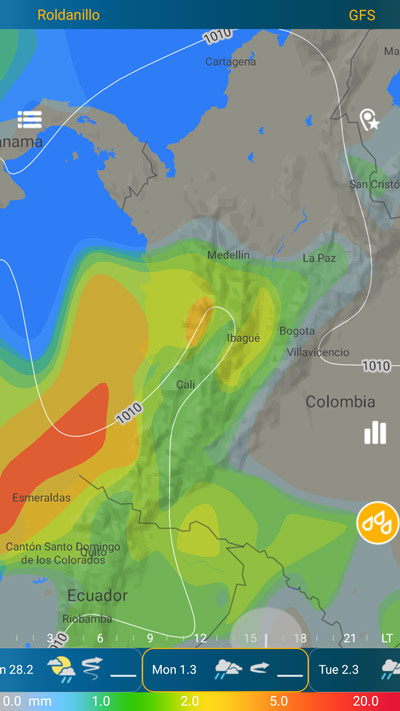Now also free widgets
How to do it
Select the main map icon with clouds and rain and select the icon for the precipitation. The precipitation cover will be displayed in the coverage range of 0..n mm/3h.Additional cloud and precipitation maps can be added or removed by clicking on the corresponding icon.

On the formation precipitation.
Rain Formation: Rain is a form of precipitation that occurs when water droplets in the atmosphere become large enough to fall to the ground. The process of rain formation involves several steps:
Evaporation: The Sun's energy causes the evaporation of water from various sources such as lakes, rivers, and oceans. This water vapor rises into the atmosphere.
Condensation: As the moist air rises, it encounters cooler temperatures at higher altitudes. The water vapor then condenses around tiny particles in the air, such as dust or pollution, forming tiny water droplets. These droplets cluster together to form clouds.
Collision and Coalescence: Within the clouds, the water droplets collide and merge with each other, growing larger in size. This process continues until the droplets become too heavy to remain suspended in the cloud.
Precipitation: Once the water droplets reach a sufficient size, gravity pulls them downward, causing them to fall from the cloud as rain. The raindrops continue to fall until they reach the ground.
Snow Formation: Snow is another form of precipitation that occurs when water vapor in the atmosphere freezes into ice crystals. The process of snow formation is as follows:
Freezing Nucleation: In cold temperatures, water vapor can bypass the liquid phase and transition directly into the solid phase as ice crystals. This process is known as freezing nucleation. Ice nuclei, such as dust particles or ice crystals from upper-level clouds, provide surfaces for water vapor to freeze onto.
Ice Crystal Growth: Once the freezing process starts, additional water vapor freezes onto the ice nuclei, causing the ice crystals to grow larger. This process continues as the ice crystals move within the cloud.
Snowflake Formation: As the ice crystals grow larger, they may encounter supercooled water droplets within the cloud. These droplets freeze onto the ice crystals, forming intricate snowflakes with unique shapes and patterns.
Precipitation: Once the snowflakes become heavy enough, they fall from the cloud and reach the ground as snow. The snowflakes remain in their solid form as they accumulate on the Earth's surface.
Both rain and snow formation are influenced by factors such as temperature, humidity, and the presence of cloud condensation nuclei. The specific processes and conditions for rain and snow formation can vary depending on the atmospheric conditions and the type of cloud involved.
Please note that this explanation provides a simplified overview, and the actual processes involved in precipitation formation can be more complex and nuanced.
